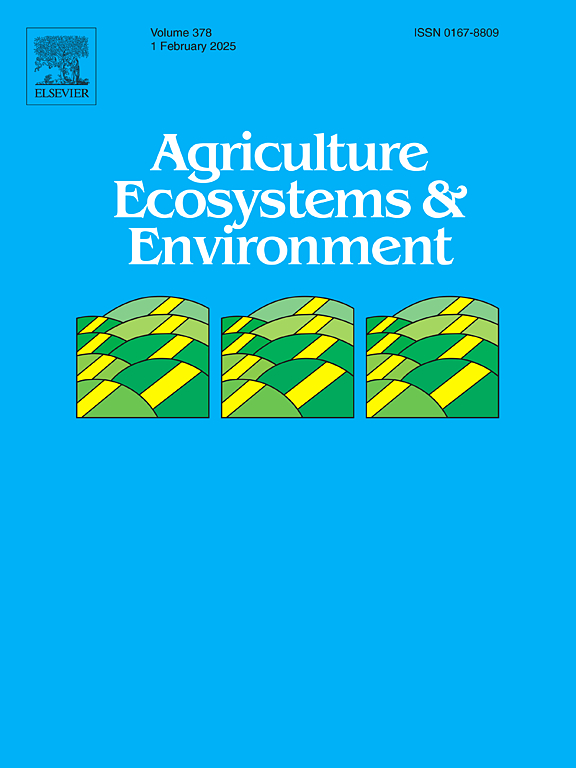The over-estimation of long-term mineral fertilizer on CO2 release from soil carbonates
IF 6.4
1区 农林科学
Q1 AGRICULTURE, MULTIDISCIPLINARY
引用次数: 0
Abstract
Soil inorganic carbon (SIC) contributes up to half to the soil carbon (C) stock globally and is especially crucial in arid and semi-arid zones. Widespread soil acidification due to fertilization neutralize carbonates getting an irrecoverable net source of CO2 out of SIC. Nevertheless, SIC is generally neglected as a CO2 source and disregarded in the C balance between soil and atmosphere. A 40-year fertilization field experiment provides an excellent option to investigate the influences of mineral and organic fertilizers on carbonate-derived CO2 efflux by partitioning CO2 sources using the δ13C signature. Although 40 years of mineral fertilizers caused soil acidification and SIC neutralization, SIC-derived CO2 was comparable with that from the control soils. This could be explained by that mineral fertilizer decreased soil-derived CO2 production and the partial pressure of soil CO2, which led to the weak reduction of SIC dissolution in the long term. Thus, the annual contribution of SIC-derived CO2 to total CO2 under long-term mineral fertilization may look as of minor importance. Organic fertilizers (manure, straw) reduced the proportional contribution of SIC-derived CO₂ by 16–42 % relative to controls, despite elevating total CO₂ emissions by 5.4–9.1 Mg C ha⁻¹ yr⁻¹. This divergence stems from Ca²⁺ inputs during organic matter decomposition, which catalyzed CO₂ reprecipitation as pedogenic carbonates, decoupling dissolution from atmospheric release. Crucially, manure amendments achieved net soil C sequestration (0.47 Mg C ha⁻¹ yr⁻¹). In contrast, straw-induced SIC losses (2.0 Mg C ha⁻¹ over 40 years) negated 52 % of SOC gains, yielding marginal net sequestration (2.4 ± 1.7 Mg C ha⁻¹). These results underscore the imperative to evaluate SIC-SOC interactions when assessing the climate efficiency of organic management. SIC-derived CO₂ efflux fluctuated seasonally, peaking during the flowering phase (19–35 % of total emissions), then declining by 5.0–9.7 %. This temporal decoupling highlights rhizosphere activity as a key regulator of SIC. Ignoring SIC contributions led to a 35 % overestimation of heterotrophic respiration in total CO₂ efflux, illustrating systemic biases in current C models. Our findings advocate for manure-based management to maximize C sequestration not as SOC but as SIC and to minimize CO2 emissions from SIC, a dual strategy to reconcile agricultural productivity with climate resilience in semi-arid regions.
长期施用矿肥对土壤碳酸盐释放CO2的高估
土壤无机碳(SIC)占全球土壤碳(C)储量的一半以上,在干旱和半干旱地区尤为重要。由于施肥导致的广泛的土壤酸化中和了碳酸盐,从碳化硅中获得了不可恢复的二氧化碳净来源。然而,碳化硅作为CO2源通常被忽略,在土壤和大气之间的碳平衡中也被忽略。通过40年的田间施肥试验,利用δ13C特征划分CO2源,为研究矿物和有机肥对碳酸盐源CO2外排的影响提供了一个很好的选择。尽管40年的矿质肥料导致土壤酸化和SIC中和,但SIC衍生的CO2与对照土壤相当。这可能是由于矿肥降低了土壤源性CO2产量和土壤CO2分压,导致碳化硅溶解在长期内减弱。因此,在长期矿物施肥下,sic衍生的CO2对总CO2的年贡献可能看起来不太重要。与对照相比,有机肥(粪肥,秸秆)减少了sic衍生的CO₂的比例贡献,减少了16-42 %,尽管总CO₂排放量增加了5.4-9.1 Mg C ha(⁻¹yr)。这种发散源于有机物分解过程中Ca 2 +的输入,催化CO 2作为成土碳酸盐再沉淀,与大气释放解耦溶解。至关重要的是,肥料改良实现了土壤碳的净封存(0.47 Mg C ha(⁻¹yr))。相比之下,秸秆引起的碳化硅损失(40年2.0 Mg C - ha毒血症)抵消了52. %的有机碳收益,产生边际净固碳(2.4 ± 1.7 Mg C - ha毒血症)。这些结果强调了在评估有机管理的气候效率时评估SIC-SOC相互作用的必要性。sic衍生的CO₂外排季节性波动,在花期达到峰值(占总排放量的19-35 %),然后下降5.0-9.7 %。这种时间解耦强调了根际活动是SIC的关键调节因子。忽略SIC的贡献导致对异养呼吸在总CO₂外排中的高估35% %,说明了当前C模型中的系统性偏差。我们的研究结果提倡以粪便为基础的管理,以最大限度地提高碳封存,而不是作为有机碳,而是作为碳化硅,并最大限度地减少碳化硅的二氧化碳排放,这是一种协调半干旱地区农业生产力与气候适应能力的双重策略。
本文章由计算机程序翻译,如有差异,请以英文原文为准。
求助全文
约1分钟内获得全文
求助全文
来源期刊

Agriculture, Ecosystems & Environment
环境科学-环境科学
CiteScore
11.70
自引率
9.10%
发文量
392
审稿时长
26 days
期刊介绍:
Agriculture, Ecosystems and Environment publishes scientific articles dealing with the interface between agroecosystems and the natural environment, specifically how agriculture influences the environment and how changes in that environment impact agroecosystems. Preference is given to papers from experimental and observational research at the field, system or landscape level, from studies that enhance our understanding of processes using data-based biophysical modelling, and papers that bridge scientific disciplines and integrate knowledge. All papers should be placed in an international or wide comparative context.
 求助内容:
求助内容: 应助结果提醒方式:
应助结果提醒方式:


